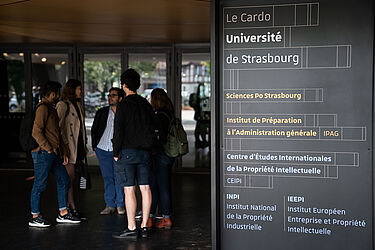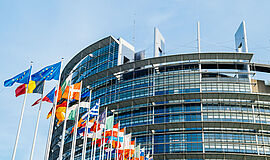

It is no coincidence that Strasbourg is one of the most attractive cities in France. Its rich history, cultural heritage and quality of life are sure to win you over. As a symbol of Franco-German reconciliation, the city enjoys unrivalled influence at both national and European level. To introduce you to the human warmth of the city, let’s hop on our bikes and take a tour around the cycle paths of Strasbourg.
We’ll start our journey in the European District. The European Parliament, the Council of Europe and the European Court of Human Rights are iconic institutions that you will have the opportunity to visit and take part in the various activities organised on site. Now, let's make our way along the cycle paths to the Orangery. This park covers 26 hectares, where you can meet up with friends, practise sports, draw and let your inspiration flow... knowing you are never very far from a stork.
From the Orangery Park, we cycle to the Parc du Contades, making a detour through the University of Strasbourg’s Botanical Gardens, where there are often exhibitions that combine art and science. We cycle on, to the BNU (National University Library), one of the city's many large libraries, which provide optimal conditions for studying.
Opposite the BNU, you have the National Theatre of Strasbourg, opened in October 1968, at the instigation of André Malraux and Hubert Gignoux. There are only five national theatres in France and Strasbourg is the only one outside Paris.
Continuing our journey across the bridge over the Canal du Faux-Rempart, we arrive at the Opéra National du Rhin, overlooking the Place Broglie, best known as the home of Strasbourg's magical Christmas markets.
Next, we turn our handlebars and pedal to the gates of the Gymnase Schoepflin. This is one of the places where you’ll have the opportunity to take part in team sports or cheer on the blue-and-whites.
Let’s carry on towards Place Kléber, dominated by the incredible Aubette building. Its avant-garde interior was designed by Theo Van Doesburg, Sophie Taeuber-Arp and Hans Jean Arp in 1928 and includes a “cinema-dance hall” and “foyer bar”.
Then we take the rue des Grandes Arcades to Place Gutenberg, named after the inventor of the printing press, who is synonymous with Strasbourg. We turn round “And then there was light” as the parchment in the hands of Gutenberg’s statue tells us, as we take in the breath-taking view of Strasbourg's Notre Dame Cathedral.

We continue on our way towards Le Cardo, Sciences Po Strasbourg’s new building, past the museums of the city and Eurometropole of Strasbourg. Pedal along the banks of the River Ill and in just a few moments we get there. We enter the building to find a huge library on one side, full of light. Opposite, the radio presenters have set up their equipment, ready for a new debate. If you want to develop your public speaking skills, diplomacy, art or sporting ability, you’ll find a student association to suit you, offering activities all year round.
Through the lower door, we enter the huge, modern and comfortable Auditorium A, and the lecture begins.
To conclude, let's look ahead to the Third Year, when IEP diploma students spend an enriching and unforgettable student experience at one of our partner universities, which are to be found on every continent. It’s time to discover new horizons before returning to the Fourth Year of the course. The first 2 years of the Sciences Po Strasbourg Diploma are intentionally multi-disciplinary and transversal, giving you time to decide which areas you are most interested in pursuing.
If the Institute’s rich course content appeals to you, if you want to develop your public speaking skills, diplomacy, art or sporting ability and meet people from all over the world during the Third Year abroad, Sciences Po Strasbourg is right for you.
Flore Delbosc, Fourth Year Sciences Po Strasbourg Diploma Student
